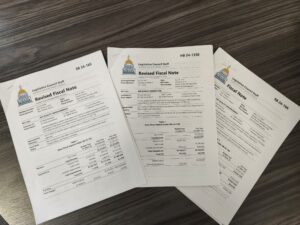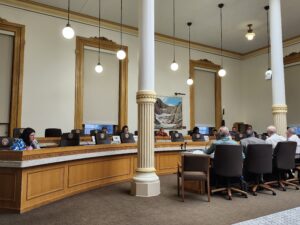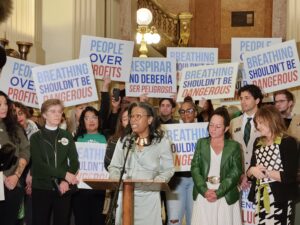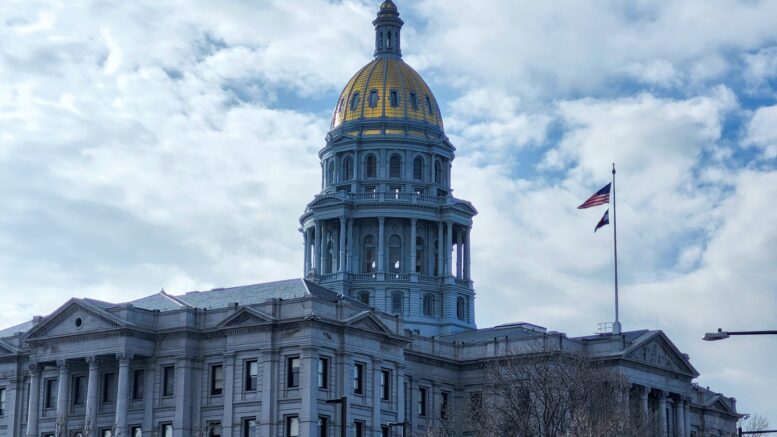As Colorado legislators sit down in the coming weeks to try to fit a large swath of spending bills into a small budget allocation that’s been left for them, three high-profile bills that came from an interim ozone committee face a two-tiered set of obstacles to becoming law.
First, the proposals — Senate Bills 165 and 166 and House Bill 1330 — carry fiscal notes that, combined, would eat up most of the $25 million placeholder that budget writers have left for general legislative priorities. Secondly, for SB 166 and HB 1330, the fiscal notes assigned to them by the Colorado Legislative Council are nowhere close to covering the amounts the Colorado Department of Public Health and Environment says it will actually need to enact and enforce them.
Those two hurdles, in addition to low scores the bills received Tuesday on appropriations ranking tallies released by House and Senate Democrats, means that the path to becoming law for the trio will be rocky and could require compromises. And it will test how big a priority the three bold proposals are for Democrats in the two chambers that the party dominates, particularly as Gov. Jared Polis’ administration has offered little to no support so far for the efforts.
What the bills do and cost
SB 166, sponsored by Democratic Sens. Faith Winter of Broomfield and Kevin Priola of Henderson, has the biggest cost associated with it — $18.8 million that would fund 93 new employees, among other expenditures, according to its fiscal note. The bill would clamp down on what supporters call lax enforcement of state environmental laws by creating new “repeat-offender” categories for companies with five or more violations in three years and requiring fines of at least 50% of the maximum civil penalty allowable.
CDPHE officials, however, tagged the bill as having a much higher cost — $80 million per year to enforce, with a need for 550 new employees, including 111 workers and $25 million for legal services alone, according to the departmental difference listed in the fiscal note. Department leaders said they’d have to conduct additional investigations of stationary-source operators every six months to fulfill the regulatory requirements of the bill rather than just receive and post reports from operators to its website, as the fiscal note assumes.

Fiscal notes are per-bill cost notes calculated by the nonpartisan Legislative Council.
“The way we oversee through compliance and enforcement is technical and very hard to explain in the time we have with an analyst,” Air Pollution Control Division Director Michael Ogletree told the Senate Transportation and Energy Committee during a March 20 hearing. “Our department difference … is appropriate for what we would need to comply with the bill as written.”
Wide chasms between CDPHE and fiscal notes
HB 1330, sponsored by Democratic Reps. Jennifer Bacon of Denver and Jenny Willford of Northglenn, would require CDPHE to do more modeling to determine whether new or expanding emitters would add to pollution in the federal ozone nonattainment area in the northern Front Range. It would bar permits in disproportionately impacted communities if new emitters would increase overall pollution areas, and it would base state officials’ determinations on this new modeling.
Legislative Council staff assigned a $2.5 million general-fund fiscal note to the bill, but CDPHE said the cost for the fiscal year beginning on July 1 would be $24.3 million and that it would need 187 new employees — 10 times the 19 workers the fiscal note presumed. Not only would the staff need to conduct modeling on emissions from every emitting unit at an affected stationary source, but workload would have to increase to approve construction permits on an expedited timeline rather than cause extensive backlogs, it asserted.
“For our department, it is a very significant lift to be able to process all the models,” Ogletree told the House Energy & Environment Committee during a March 7 hearing in which one of his deputies explained that the bill requires more complex modeling. “The permits we don’t model, it is because they are a decrease in emissions … We’d need to be modeling decreases in emissions.”

Colorado state Rep. Jenny Willford (left) watches a panel of witnesses speak last month against her bill to increase air-quality permitting regulations.
Why the differences with fiscal notes matter
SB 165, sponsored by Priola and Democratic Sen. Lisa Cutter of Morrison, would take several actions, including pausing oil-and-gas preproduction activities from June through August, launching rulemaking to limit indirect-source emissions and putting into statute Polis’ executive order for drillers to decrease nitrous oxide emissions. Tagged with a $1.3 million cost to the general fund for next year, the fiscal note has a smaller departmental difference — about $500,000 and 3.5 to 6.5 full-time equivalent employees annually.
Such large departmental differences are rare on fiscal notes, and what legislators must consider is whether the smaller amount of money that a fiscal note would allocate for implementation of a bill would be enough to accomplish its aims. If CDPHE were not able to fund the enforcement that both SB 166 and HB 1330 demand, for example, the result would be either a shortfall in pollution reduction or creation of a permitting backlog that could grind to a halt the operations of companies looking to drill wells or grow manufacturing facilities.
All three bills stem from the Legislative Interim Committee on Ozone Quality created in HB 23-1294, a bill that originally proposed significant regulatory increases for air-quality permitting but was pared back to creation of the committee and some smaller changes. Part of the reason for the paring was pushback from the Polis administration that the changes demanded by the bill would interfere with air-cleaning efforts already underway in CDPHE and would be difficult to implement by the short-staffed department.

Colorado state Rep. Jennifer Bacon speaks about a new slate of environmental bills in February at the Capitol.
The budget process
Last year’s bill, as it was first proposed, would have created expenditures of $11.3 million in its first year, as well as a need to hire 111 new employees. This year’s three ozone bills would cost a combined $22.6 million and mandate hiring of 119 employees, according to fiscal notes — or $105.6 million and 748 new employees, according to department figures.
Over the past two weeks, House and Senate members approved a $40.6 billion state budget for the 2024-25 fiscal year, as Colorado Politics and other outlets have reported. Now the Joint Budget Committee must work out differences in the two versions brought about by amendments passed during debate on each chamber floor.
Meanwhile, bills that have been backed up for weeks or months in finance and appropriations committees as legislators waited to see how much room there would be in the budget to fund them will be getting hearings soon that could determine their fate. Those include the three air-quality bills that sprang from the ozone committee.
On Tuesday, House and Senate Democratic leaders — those who largely will control the fate of bills due to the party’s 46-19 margin in the House and 23-12 margin in the Senate — calculated results of polling within caucuses on which bills should get priority for funding, according to documents provided to The Sum & Substance. Those results also raise questions about the future of the ozone bills.
Competition for funding is steep
While legislators were allowed to rank 20 priority bills with expenditures of $200,000 or more, 17 of the 34 responding House members did not list HB 1330 of being in their top 20, and 11 of the 12 responding senators left it off their lists too. Some prioritized it within their top bills — Bacon, the assistant majority leader who ranks as the No. 3 Democrat in the House, put it atop her list, for example.
However, HB 1330 fared much better in the intra-caucus polling than either of the Senate ozone bills.
SB 166 was left off the rankings by 27 of the 34 House Democrats and 10 of the 12 Senate Democrats. However, it was listed as the No. 1 funding priority by two Democrats — Rep. Jennifer Parenti of Erie and Winter, its Senate sponsor who also is assistant majority leader in that chamber.
SB 165, meanwhile, was not ranked by 28 of the 34 House Democrats and 11 of the 12 Senate Democrats. Two of the senators who declined to rank either it or SB 166 were Senate President Steve Fenberg and Senate Majority Leader Robert Rodriguez, who wield a lot of control over the order in which bills are heard.
Fiscal notes just part of overall considerations
The ranking system, which came about this year after a court scolded Democrats for their secretive ranking process from years past that determined funding priorities, is not a complete indicator of the future success of bills. More than one-quarter of House Democrats and nearly half of Senate Democrats did not weigh in, though their opinions are likely to be considered in other ways, and legislators often find ways to cut the price tags associated with bills.
Also, backers of the bills will continue to emphasize that their value to the state should be considered well beyond just their immediate price tags, as they expect future decreases in medical bills and other cleanup costs if the measures pass. The northern Front Range is listed as being in severe nonattainment of federal ozone standards, and residents in the most polluted areas have conveyed to legislators their stories of increased health conditions and exacerbation of asthma because of pollution.
But between the concerns of CDPHE leaders over operational costs of the proposed laws being pegged too low, the already high costs of the bills and the small hole in the budget for bills needing general-fund spending, it’s clear their roads to passage are complicated, even as legislative leaders have prioritized cleanup of air pollution. And those debates will come to a head before May 8, when the legislative session is required to adjourn.
